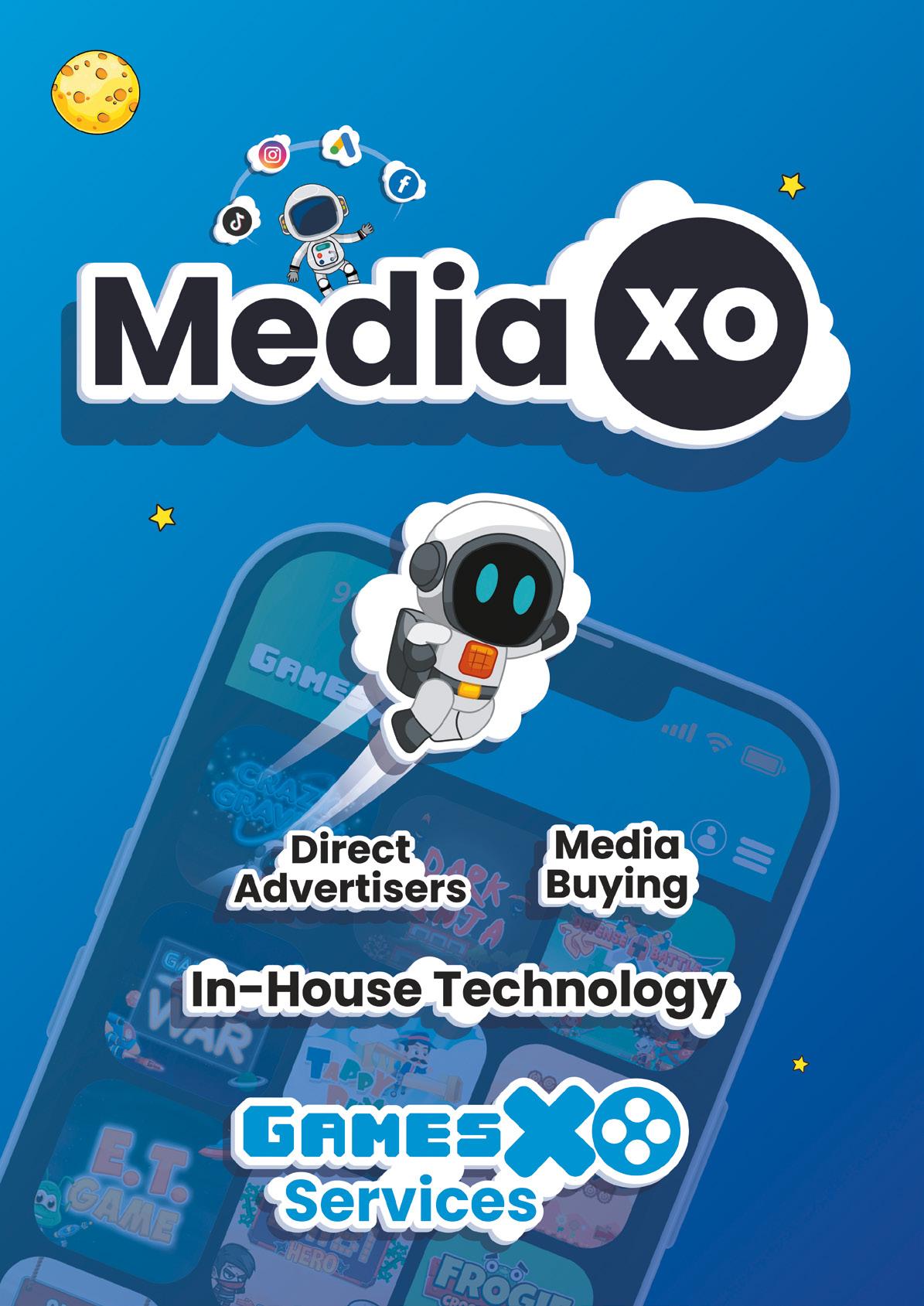
9 minute read
The untapped goldmine: commerce Media offers MNOs a billiion dollar payday
Mobile network operators (MNOs) are no longer just connectivity providers – they are set to become media companies. Sitting on a treasure trove of data – user behaviour, location and preferences – they are stand at the doors to a goldmine: commerce media, and $820bn opportunity if analysts are to be believed.
Commerce media leverages user data to deliver targeted advertising within the purchase funnel, significantly influencing consumer decisions. This presents a phenomenal opportunity for MNOs to transform themselves from connectivity providers to key players in the advertising ecosystem.
THE POWER OF FIRSTPARTY DATA
MNOs possess a unique advantage in the digital world, they ‘own’ a wealth of first-party data on their subscribers. This data is unmatched by other players in the advertising landscape and includes demographic data such as age, gender, location, income bracket; device usage patterns such as how long they dwell and where; and how much data they use, their location and the kind of content they like.
This rich tapestry of data allows MNOs to create highly targeted consumer segments with incredible accuracy. Imagine targeting a fitness app campaign – with MNO data, you can show ads to users with high evening activity levels and frequent downloads of health apps, significantly improving campaign effectiveness.
And it is a massive potential market. The global commerce media market is projected to reach a staggering $820bn by 2030, according to a report by McKinsey. This explosive growth highlights the immense potential for MNOs to carve out a significant share in this lucrative space.
BEYOND TARGETING
However, MNOs can go beyond basic targeting by leveraging realtime contextual data. Imagine a user searching for a new pair of running shoes online. Through their network activity, the MNO can identify this user and serve them a targeted ad for a sports apparel store in their vicinity. This contextual relevance delivers a seamless user experience and significantly increases the likelihood of conversion.
MNOs can also offer advertisers a variety of engaging formats to reach their target audience within the mobile ecosystem.
SMS is a key one. Targeted promotional offers and discount codes delivered directly to users’ phones. A 2023 study by SMS Marketing Trends found that SMS marketing boasts a staggering 98% open rate, making it a highly effective format.
Serving targeted ads within popular mobile apps based on user data and app usage patterns opens another window of opportunity for many MNOs. The global in-app advertising market was valued at $188.3bn billion in 2023, according to Statista, highlighting the potential reach and revenue opportunities.
Rich media ads are also becoming a reality, not least as RCS gets rolled out. Interactive video ads or location-based banners with click-to-call functionalities for immediate conversions. Rich media ads can increase brand recall and engagement compared to traditional static banners.
Native advertising also plays a role. Seamlessly integrating branded content within mobile apps or websites, creating a less intrusive advertising experience. Native advertising can generate higher click-through rates compared to traditional banner ads.
A MULTIFACETED OPPORTUNITY FOR MNOS
Embracing commerce media offers a multi-pronged benefit for MNOs potentially brings operators a raft of opportunities. Creating a new revenue stream through targeted advertising partnerships with brands seeking a highly engaged customer base, being the main one.
But there are many others. Enhanced customer value can also be added. Providing a more personalised and enriching mobile experience for subscribers with relevant advertising, potentially leading to increased satisfaction and loyalty.
Analysing user behaviour within the commerce media platform can provide MNOs with valuable insights to optimise their
network offerings, personalise future campaigns and develop new value-added services. There are also improved customer retention possibilities. By delivering relevant and engaging advertising experiences, MNOs can potentially increase customer satisfaction and loyalty, reducing churn.
NAVIGATING THE LANDSCAPE
While the opportunity is undeniable, there are challenges MNOs need to consider. As with any consumer-facing service that leverages first-party data, data privacy is a paramount concern. MNOs need to ensure transparency and user consent regarding data collection and usage for advertising purposes. Building trust with their subscribers is crucial for the long-term success of commerce media initiatives.
To cope with this – as well as with creating a media business – MNOs may need to invest in building expertise in ad targeting, campaign management and data analytics and management to effectively compete in the commerce media space. This might involve hiring specialists or partnering with established adtech companies.
Competition is also a growing concern. Established advertising platforms like Google and Facebook are formidable competitors with extensive infrastructure and established relationships with advertisers. MNOs need to offer unique value propositions and data insights to attract advertisers in this crowded space.
Data privacy regulations are constantly evolving. MNOs need to stay compliant with all current and future legislation. This requires ongoing monitoring of changing regulations and adapting their data collection and usage practices accordingly.
COLLABORATIVE FUTURE

collaborative. MNOs can unlock their full potential by partnering with key players:
• Ad tech companies: MNOs can leverage the expertise of ad tech companies in ad targeting, campaign management, and data analytics to build robust commerce media platforms and compete effectively with established players.
• Brands: MNOs offer brands access to highly targeted user segments and unique advertising formats that traditional advertising platforms might not provide. Building strong relationships with brands will be crucial for MNOs to attract advertising dollars.
• App developers: Integrating commerce media functionalities within popular mobile apps can create a seamless user experience. MNOs can partner with app developers to create targeted advertising opportunities within their apps, generating a revenue stream for both parties.
By working together, MNOs,
ad-tech companies, brands, and app developers can create a winwin situation for all stakeholders.
Advertisers gain access to valuable first-party data for targeted campaigns, MNOs create new revenue streams, and users receive a more personalized mobile experience.
The mobile commerce media market represents a golden op-
portunity for MNOs. MNOs possess a unique advantage through their vast first-party data and the ability to leverage real-time contextual insights. By overcoming challenges like data privacy concerns and building expertise in the advertising space, MNOs can unlock substantial revenue streams and enhance the value proposition for their subscribers.
Collaborative partnerships with ad-tech companies, brands, and app developers will be key to success in this rapidly evolving landscape.
As commerce media continues to grow, MNOs who embrace this opportunity are poised to become significant players in the mobile advertising ecosystem of the future.
Paving the way: who has taken a lead in MNO commerce media?
So, who is doing this today and how is it going? Several MNOs are already taking bold steps to integrate commerce media into their offerings:
• Verizon Media: Verizon, a leading American MNO, launched its own advertising platform, Verizon Media. This platform leverages its vast user data to offer targeted advertising solutions for brands, demonstrating their commitment to the commerce media space. In 2022, Verizon Media reported advertising and subscription revenues exceeding $2bn, highlighting the potential financial gains from this venture.
• Singtel’s Amobee: Singtel, a major Singaporean telecommunications company, acquired Amobee, a global ad tech company. This acquisition demonstrates Singtel’s strategic move to establish itself as a player in the commerce media arena, leveraging Amobee’s expertise in ad targeting and campaign management.
• Telefonica’s AdTech unit: Telefonica, a Spanish MNO, established a dedicated AdTech unit to develop and sell targeted advertising solutions to brands. This dedicated unit signifies Telefonica’s commitment to building expertise in commerce media and carving out a niche in this growing market.
The superbundling add on
Bango has spent more than a year pushing the idea that telcos can generate increased revenues if they allow users to aggregate streaming services and then pay via the telco for them.
This idea of super bundling isn’t new, but the latest push towards sportsVOD is timely. This summer sees the European football championships take place in Germany across June and July, followed swiftly by the Olympics in Paris in July and August. These are crammed in around the host of other on-going sporting events taking place worldwide this summer and cements just how important sports are commercially to anyone in the content business.
Sports fans are the biggest adopters of streaming package, with the average US sports fan having seven and spending some $1440 a year. However, many of them – 73% according to Bango – want more but can’t afford it and are also put off by the complexity and scale of just how many sports services there are out there.
Given this fragmentation, 87% of those paying for SportsVOD subscriptions are calling for a single ‘content hub’ to centralise all of their sports subscriptions (and more) into one place. Without this sort of all-in-one solution, 55% of sports streamers admit to using pirate streaming services to access all of their favourite content in one place.
The piracy aside – which indicated a market in crisis, rather than unwilling consumers – this shows, believes Bango, that sports fans are more than ready for super bundling. Further, they say that they want their MNO to provide it.
Running the numbers, Bango believes that telco customers would pay around 38% more on their monthly phone bill for this – a substantial increase in revenues.
What is intriguing is that there still seems to be some degree of reticence among MNOs to do this. They need to create new revenue streams to counter commoditisation of messaging and voice, an aggregating content and billing for it – potentially with DCB – is one option for them.
There are challenges with super bundling for telcos. Securing rights to bundle popular content from different providers can be expensive. Telcos need to negotiate favourable deals while offering a diverse and attractive range of content. Telcos would also be entering a crowded market already occupied by established streaming giants. They would need to differentiate their offerings by providing unique value propositions or competitive pricing. Likewise, negotiating revenue sharing agreements with content providers can be complex. Telcos need to ensure they get a fair share of the profits while keeping their bundles affordable for customers.
Then there are the tech integration and data issues – telcos need to invest in robust infrastructure to ensure a smooth user experience and super bundles often include unlimited or generous data allowances to accommodate streaming – both of which are costly.









